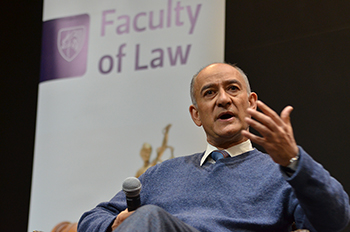Twenty years of the constitution of South Africa – cause for celebration and reflection

Judge Azar Cachalia |
The University of the Free State’s Centre for Human Rights and the Faculty of Law held the celebration of the twentieth anniversary of the adoption of the South African Constitution on 11 May 2016 on the Bloemfontein Campus. Students and faculty members celebrated and reflected on not only the achievements of the constitution but also on perspectives regarding its relevance in modern society, and to what extent it has upheld the human rights of all citizens of South Africa.
The panel discussion started with a presentation on the pre-1996 perspective by Judge Azar Cachalia of the Supreme Court of Appeal. Judge Cachalia reflected on his role in the realisation and upholding of the constitution, from his days as a student activist, then as an attorney representing detainees during political turmoil, and currently as a judge: “My role as an attorney was to defend people arrested for public violence. My role as a judge today is to uphold the constitution.” He stressed the importance of the constitution today, and the responsibility institutions such as the police service have in upholding human rights. Judge Cachalia played a significant role in drafting the new Police Act around 1990, an Act which was to ensure that the offences perpetrated by the police during apartheid did not continue in the current democratic era. Further, he pointed out that societal turmoil has the potential to make society forget about the hard work that was put into structures upholding human rights. “Constitutions are drafted in moments of calm. It is a living document, and we hope it is not torn up when we go through social conflict, such as we are experiencing at present.”
Thobeka Dywili, a Law student at the UFS, presented her views from the new generation’s perspective. She relayed her experience as a student teaching human rights at schools in disadvantaged communities. She realised that, although the youth are quite aware of their basic human rights, after so many years of democracy, “women and children are still seen as previously disadvantaged when they should be equal”. She pointed out that, with the changing times, the constitution needs to be looked at with a new set of eyes, suggesting more robust youth engagement on topics that affect them, using technology to facilitate discussions. She said with the help of social media, it is possible for a simple discussion to become a revolution; #feesmustfall was a case in point.
Critical perspectives on the constitution were presented by Tsepo Madlingozi of University of Pretoria and University of London. In his view, the constitution has not affected policy to the extent that it should, with great disparities in our society and glaring issues, such as lack of housing for the majority of the poor. “Celebration of the constitution should be muted, as the constitution is based on a decolonisation approach, and does not directly address the needs of the poor. The Constitutional Court is not pro-poor.” He posed the question of whether twenty years on, the present government has crafted a new society successfully. “We have moved from apartheid to neo-apartheid, as black elites assimilate into the white world, and the two worlds that exist have not been able to stand together as a reflection of what the constitution stands for.”
Prof Caroline Nicholson, Dean of the Faculty of Law, encouraged more open discussions, saying such dialogues are exactly what was intended by the Centre for Human Rights. She emphasised the importance of exchanging ideas, of allowing people to speak freely, and of sharing perspectives on important issues such as the constitution and human rights.